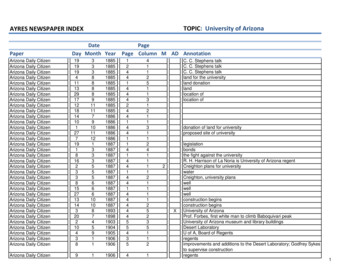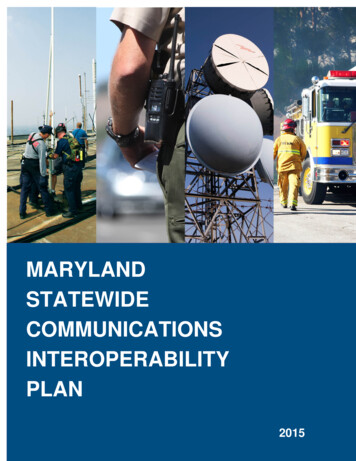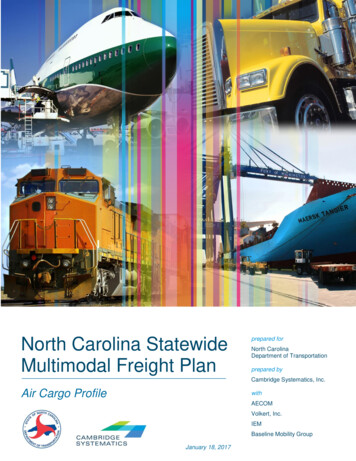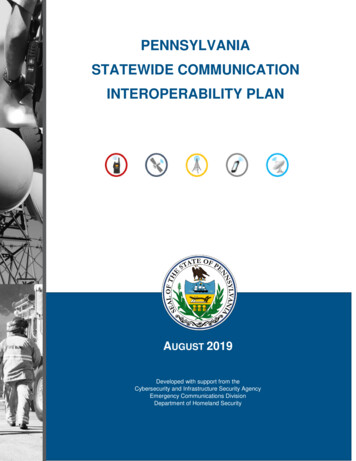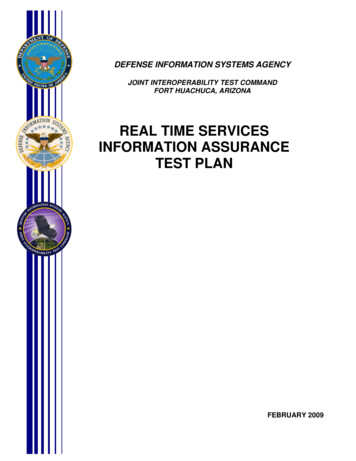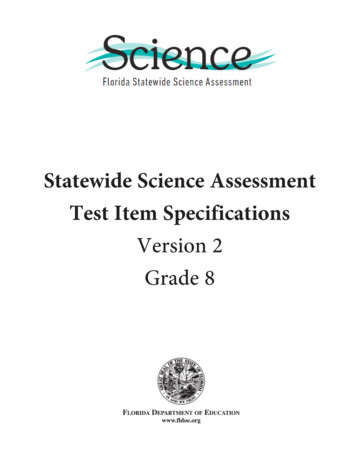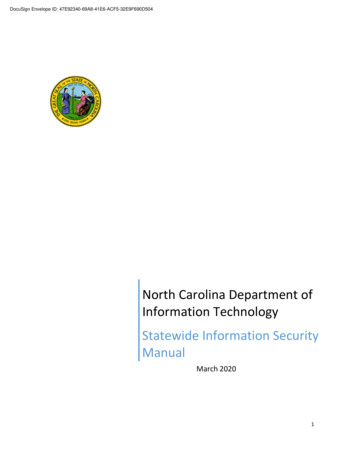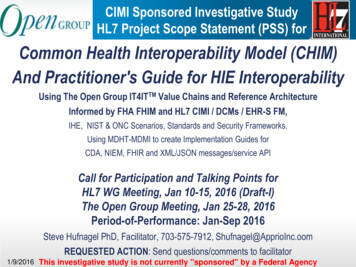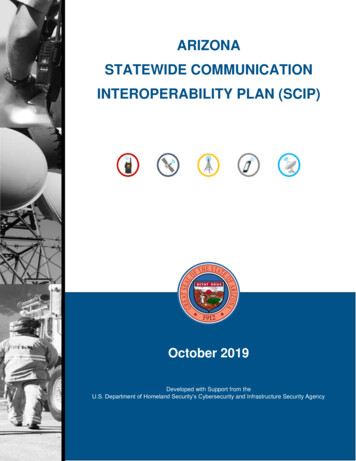
Transcription
ARIZONASTATEWIDE COMMUNICATIONINTEROPERABILITY PLAN (SCIP)October 2019Developed with Support from theU.S. Department of Homeland Security’s Cybersecurity and Infrastructure Security Agency
ARIZONA STATEWIDE COMMUNICATION INTEROPERABILITY PLAN – OCTOBER 2019TABLE OF CONTENTSLetter from the Statewide Interoperability Coordinator . 1Introduction. 3Interoperable and Emergency Communications Overview . 4Vision and Mission . 5Governance . 6Statewide Interoperability Executive Council . 6National Governors Association Regional Workshop . 6Technology . 8Land Mobile Radio . 8Mobile Broadband . 89-1-1/Next Generation 9-1-1 . 8Alerts and Warnings. 9Funding . 10Current State of Funding . 10Implementation Plan. 11Appendix A: List of Acronyms . 16i
ARIZONA STATEWIDE COMMUNICATION INTEROPERABILITY PLAN – OCTOBER 2019LETTER FROM THE STATEWIDE INTEROPERABILITYCOORDINATORGreetings,As the Statewide Interoperability Coordinator for the State of Arizona, I am pleased to presentthe 2019 Arizona Statewide Communication Interoperability Plan (SCIP). This SCIP representsArizona’s continuous commitment to improving emergency communications interoperabilityand supporting our public safety practitioners throughout the state. In addition, this updatemeets the requirement of the current U.S. Department of Homeland Security (DHS) grantguidelines.Representatives from the following federal, state, local, and tribal agencies collaborated toupdate the SCIP: Arizona Department of Public Safety(DPS)Arizona Department of HomelandSecurity (AZDOHS)FirstNetArizona Department of Emergencyand Military Affairs (DEMA)University of ArizonaNorthwest Fire District AZPhoenix Police DepartmentScottsdale Police DepartmentMaricopa County EmergencyManagementArizona Department ofAdministrationMesa Police DepartmentPeoria Police DepartmentMarana Police DepartmentYuma Regional CommunicationsSystem (YRCS) Chandler Police DepartmentAk-Chin Indian CommunityTown of Oro ValleyGilbert Police DepartmentPima County Office of EmergencyManagementGila River Police DepartmentNavajo CountyGila CountyCity of GlendaleCochise CountyNavajo NationCity of BuckeyePinetop Fire DepartmentTohono O’odham NationCity of SurpriseCity of TucsonCity of TempeRio Rico Medical & Fire DistrictTown of WinslowThe updated SCIP includes actionable and measurable goals and objectives with a focus ongovernance, technology, and funding. They are designed to support our state in planning fornew technologies and navigating the ever-changing emergency communications ecosystem.They also incorporate recommendations identified during Arizona’s participation in the NationalGovernors Association (NGA) Northeast Regional Workshop on Enhancing Public SafetyCommunications Governance that was conducted in partnership with the DHS Cybersecurityand Infrastructure Security Agency (CISA).1
ARIZONA STATEWIDE COMMUNICATION INTEROPERABILITY PLAN – OCTOBER 2019As we continue to enhance interoperability, we must remain dedicated to improving our abilityto communicate among disciplines and across jurisdictional boundaries. With help from publicsafety practitioners statewide, we will work to achieve the goals set forth in this SCIP andbecome a nationwide model for statewide interoperability.Sincerely,Jeremy KnollArizona Statewide Interoperability Coordinator2
ARIZONA STATEWIDE COMMUNICATION INTEROPERABILITY PLAN – OCTOBER 2019INTRODUCTIONThe Arizona Statewide Communications Interoperability Plan (SCIP) is a stakeholder-driven,multi-jurisdictional, and multi-disciplinary strategic plan to enhance interoperable andemergency communications over the next two to three years. This document contains thefollowing planning components: Introduction: Provides the context necessary to understand what the SCIP is and how itwas developed.Interoperable and Emergency Communications Overview: Provides an overview ofArizona’s current and future emergency communications environment.Vision and Mission: Articulates Arizona’s two- to three-year vision and mission forimproving emergency communications operability, interoperability, and continuity ofcommunications at all levels of government.Goals and Objectives: Outlines the goals and objectives aligned with the vision andmission of the SCIP as they pertain to Governance and Technology.Implementation Plan: Describes Arizona’s plan to implement, maintain, and update theSCIP and enable continued evolution of and progress toward Arizona’s interoperabilitygoals.The Emergency Communications Ecosystem consists of many inter-related components andfunctions, including communications for incident response operations, notifications and alertsand warnings, requests for assistance and reporting, and public information exchange. The3
ARIZONA STATEWIDE COMMUNICATION INTEROPERABILITY PLAN – OCTOBER 2019primary functions are depicted in the 2019 National Emergency Communications Plan(NECP) 1.0FThe Interoperability Continuum, developed by SAFECOM and shown in Figure 1, serves as aframework to address challenges and continue improving operable/interoperable and publicsafety communications. It is designed to assist public safety agencies and policy makers withplanning and implementing interoperability solutions for communications across technologies.More information on the Interoperability Continuum is available in ECD’s InteroperabilityContinuum brochure.2Figure 1: Interoperability ContinuumINTEROPERABLE AND EMERGENCY COMMUNICATIONSOVERVIEWReliable, timely communications among public safety responders, public safety agencies andcitizens is critical to effectively carry out public safety missions, and in many cases, savinglives.Traditional voice capabilities, such as land mobile radio (LMR), landline and wireless 9-1-1services have long been and continue to be critical tools for communications. However, theadvancement of internet protocol (IP) based technologies in public safety, has increased theThe 2019 NECP is available here: rgency-communications-planThe Interoperability Continuum Brochure is available cations/interoperability continuum brochure 2.pdf124
ARIZONA STATEWIDE COMMUNICATION INTEROPERABILITY PLAN – OCTOBER 2019type and amount of information responders receive, the tools they communicate with, andcomplexity of new and interdependent systems. New technologies increase the need forcoordination across public safety disciplines, communications functions, and levels ofgovernment to ensure emergency communications capabilities are interoperable, reliable, andsecure.An example of this evolution is the First Responder Network Authority’s (FirstNet)implementation of the Nationwide Public Safety Broadband Network (NPSBN). All 56 statesand territories, including Arizona, have opted into FirstNet. With this new system, agencies cansupplement existing LMR capabilities with improved spectrum, broadband capabilities, and themeans to move and transfer data as never before. Its adoption and implementation will entailclose coordination with 9-1-1 administrators, dispatch supervisors, LMR systems managersand managers of alert and warning systems to ensure interoperability and cybersecurity arenot sacrificed as agencies begin adopting wireless cellular devices for daily operations.Similarly, the transition of public-safety answering points (PSAPs) to Next Generation 9-1-1(NG9-1-1) technology will enhance sharing of critical information in real-time through the use ofmultimedia—such as pictures, video, and text — among citizens, PSAP operators, dispatch,and first responders. While the benefits of NG9-1-1 are tremendous, interfacing systems alongwith governance, standard operating procedures and training are necessary to fully realizethese benefits and ensure the security of information are all key elements to successfulimplementation.VISION AND MISSIONThis section describes Arizona’s vision and mission for improving emergency communicationsoperability, interoperability, and continuity of communications statewide:Vision:To achieve interoperable communications within all areas of the emergencycommunications ecosystemMission:Implement and strengthen governance within Arizona to enhance and sustain all elementsof the emergency communications ecosystem5
ARIZONA STATEWIDE COMMUNICATION INTEROPERABILITY PLAN – OCTOBER 2019GOVERNANCEStatewide Interoperability Executive CouncilArizona currently has no governance body in place for Emergency Communications. Instead,the SWIC currently manages all public safety and emergency communications andinteroperability statewide. Addressing the technical problems and challenges occurs ad hoc byinterested parties. The workshop attendees established the ad-hoc SCIP Working Group tooversee the implementation of the 2019 SCIP until the establishment of a formal governancebody. The SCIP Working Group identified several challenges regarding governance,technology, and funding.Arizona seeks to formalize a governance body by re-establishing the Statewide InteroperabilityExecutive Council (SIEC) with membership from various disciplines across state. The SIEC willenhance governance and develop statewide public safety communications (LMR, 911,Broadband, Alerts and Warnings) for all Public Safety Agencies to collaborate. This would setstandards to further interoperability needs for all jurisdictions. At present, a draft executiveorder has been written and is being discussed with the Governor’s office staff.In creating the ideal state for the Arizona SIEC, the SCIP Working Group has proposed thefollowing model. Figure 2 depicts the proposed organizational structure of the SIEC.Statewide InteroperabilityExecutive Committee (SIEC)Training andExercisesWorking GroupLMR WorkingGroup911 WIC)BroadbandWorking GroupAlerts andWarningsWorking GroupFigure 2: Proposed Statewide Interoperability Executive Council Organization ChartNational Governors Association Regional WorkshopDuring the March 2018 National Governors Association (NGA) Regional Workshop, theArizona State Team identified the following activities: Convene stakeholders who reviewed the Business Case – Why we are asking to createthe SIECCollect anecdotes of stories of when communications worked well and when it did notDraft Business Case6
ARIZONA STATEWIDE COMMUNICATION INTEROPERABILITY PLAN – OCTOBER 2019 Convene stakeholders identified in the draft executive order to discuss the businesscase, the executive order, and updating the SCIPBrief directors of respective agencies on the business casePresent business case at the Law Enforcement SummitCreate an outline of the working groups of the SIECProvide the Governor’s Public Safety Advisor the business caseGovernance#GoalsObjectives1.Formalize and fund SWIC position and office2.Establish the SIEC to represent the public safetycommunications ecosystem1.1 Express support and endorsement (e.g., letter,phone call) for host agency for decision-making levelSWIC position1.2 Pursue action to secure and sustain the position2.1 Identify advocates and supporters2.2 Establish structure and champions2.3 Identify decision makers/ elected officials tosupport SIEC2.4 Socialize business case to garner buy-in andsupport2.5 Pursue action to secure and sustain the SIEC2.6 Create Bylaws for the SIEC3.1 Use plain language on daily and multi-agencyevents. Include agency and call signs3.2 Adopt minimum training standards statewide forend users and telecommunicators3.3 Program shared interoperability channels in allradios if it is adopted as a regional standard (i.e.,Priority Programming Guide)3.4 Expand the SOPs within Arizona to develop acohesive guide to interoperability beyond individualcounties3.5 Review and revise Arizona Minimum Equipmentstandards for interoperable communicationstechnology; incorporate into grant guidance4.1 Track testing and evolution of ISSI/CSSItechnologies and other bridging technologies4.2 Revise and update the state channelprogramming guide4.3 Engage with National Public SafetyTelecommunications Council (NPSTC) and othernational bodies to ensure consistency3.Share operational best practices and implementregionally and nationally recognized standardsfor technology across the state4.Continue to encourage use of common/ sharedchannels within Arizona7
ARIZONA STATEWIDE COMMUNICATION INTEROPERABILITY PLAN – OCTOBER 2019Governance#GoalsObjectives4.4 Determine operational needs and feasibility ofdeploying fixed gateway technologiesTECHNOLOGYLand Mobile RadioThe State of Arizona will benefit from the entire state being on a single Land Mobile Radio(LMR) system. Currently during emergencies there are not enough statewide interoperable talkgroups. A statewide system with interoperable talk groups, programmed to work with federal,state, local and tribal agencies would be a tremendous value to the state. It would facilitate theusage of an interoperable communications system and encourage LMR inter-systeminteroperability. This level of integration of emerging technologies, outreach and education oninteroperability resources and channels will be critical to enhancing LMR interoperability.Integration of technologies along with updates and modernization of the current LMR systemwill also improve overall coverage.Mobile BroadbandCurrently, broadband integration between LMR and 9-1-1 is beginning to converge and thestate is trying to leverage the technology it has while remaining conscientious to not create anyroadblocks to interoperability through competing standards or applications. Arizona isinterested in ensuring that an independent body is available to advise agencies on whatbroadband integration can do, what its weaknesses are, and how LMR and broadband canwork hand-in-hand but not replace each other. Integrating FirstNet into the communicationsecosystem as well as leveraging NG9-1-1 capabilities will enhance the benefits of broadbandtechnology. The state will be able to gain statewide 4G and emerging 5G Data coverage andencourage a standardization of public safety broadband.9-1-1/Next Generation 9-1-1Arizona’s 9-1-1 Program office interfaces with a single point of contact identified as a 9-1-1System Administrator who represents the Public Safety Answering Points (PSAP) within theirpolitical subdivision. The state currently has several 9-1-1 initiatives competing for space withmultiple cities and counties continuing to migrate to Next Generation 9-1-1. An ideal statewould be for all 9-1-1 systems used in Public Safety to be leveraged for the highest benefit forpublic safety personnel. In this way 9-1-1 and cybersecurity vulnerabilities could be addressedand funding for 9-1-1 could reflect the current state of end users and fees.8
ARIZONA STATEWIDE COMMUNICATION INTEROPERABILITY PLAN – OCTOBER 2019Alerts and WarningsEmergency Management coordinates with the National Weather Service (NWS), theDepartment of Public Safety (DPS), and the Arizona Broadcaster’s Association (ABA) toensure that the Emergency Alert System (EAS) is functioning and reaching all intendedrecipients. To achieve Arizona’s goals for enhancing Alerts and Warnings, AZDEMA will needto work with Arizona Department of Administration and the Governor’s Office to seek out astatewide enterprise solution to alerts and warnings. In this way, alerts and warnings could bestandardized and outreach to the public would increase.Technology#GoalsObjectives5.Coordinated integration of broadband technologywhile recognizing that broadband will not replaceexisting LMR voice systems in the foreseeablefuture6.Support the Communications Unit (COMU)recognition program and continued education7.Encourage use of interoperable communications foroperations5.1 Continue outreach and education of emergingtechnologies and encourage phases releases5.2 Identify long and short-term governance needs5.3 Identify coverage area needs5.4 Identify application needs (software andhardware interoperability)5.5 Ensure regional and state shared systems arestandards based or have standard interfaces toallow flexibility for end user products5.6 Build system approach to interoperabilityinterstate and nationally; enhance plans to leveragecooperation6.1 Update current COMU recognition procedure6.2 Disseminate COMU information to Arizonastakeholders6.3 Identify operability and interoperability trainingneeds6.4 Identify a clearinghouse for training materials inone location. Training materials to be provided inmultiple medias (e.g., web, video, paper)6.5 Promote communications training and bestpractices6.6 Promote the COMU program for all hazardsexercise program7.1 Ensure communications personnel are includedin planning, exercises, and major events7.2 Encourage interoperable resources to be usedfor routine events and exercises to institutionalizeuse daily7.3 Educate command and executive personnel onthe value of interoperable communications9
ARIZONA STATEWIDE COMMUNICATION INTEROPERABILITY PLAN – OCTOBER 2019Technology#Goals8.Develop outreach programs tailored to differentaudiences to promote and sustain interoperablecommunications ecosystem including LMR, NG 9-11, broadband, and Alerts and Warnings9.Enhance cybersecurity capabilities to securecommunications systems within ArizonaObjectives7.4 Train response personnel on the use ofinteroperable communications8.1 Remind stakeholders of the Priority ProgramGuide8.2 Promote existing Arizona Interagency RadioSystem (AIRS) training materials (e.g., video, CD,publication)8.3 Identify and assemble an outreach workinggroup comprised of subject matter experts8.4 Educate elected officials on the interoperablecommunications ecosystem including LMR, NG9-11, broadband, and Alerts and Warnings9.1 Leverage the cyber task force in the statewidefusion center9.2 Coordinate with stakeholders to understandexisting capabilities and additional needs9.3 Develop a notification protocol of cybersecurityincidents9.4 Share information through the SIECFUNDINGCurrent State of FundingThe State of Arizona budgetary constraints and sustainable funding is still an issue. With a lackof leveraging funding coordination, the state could benefit from exploring methods of fundingfor interoperability projects through coordinated efforts. The state could also identify or createnew sustainable funding statewide that can be supported by all public safety entities includingNGOs, local, county, tribal, state, federal, and international agencies. This would ultimatelylead to funding for a full time SWIC and support staff.Funding#Goals10. Identify or create new sustainable funding sourcesfor interoperability and capitalize on coordinatedeffortsObjectives10.1 Explore Federal funding opportunities toexpand interoperable technologies in the state10.2 Identify realistic and sustainable funding plansfor the full life cycle of interoperable communicationsequipment10
ARIZONA STATEWIDE COMMUNICATION INTEROPERABILITY PLAN – OCTOBER 201910.3 Engage national organizations or employeeassociations to solicit support for fundingopportunities10.4 Support sufficient level of tax to fund NG9-1-1across the state10.5 Review identified funding streams based on ananalysis of available funds and gaps in funding forinteroperable and emergency communicationsprioritiesIMPLEMENTATION PLANThe SWIC will be the central point of coordination for implementing SCIP goals and objectiveswhich are intended to support the dissemination of best practices across the state and may beamended as necessary. The SCIP will be reviewed and updated, if needed, on an annualbasis to track progress and ensure fulfillment of current and future grant funding requirements.The Cybersecurity and Infrastructure Security Agency (CISA) publishes a catalog of TechnicalAssistance (TA) service offerings each year to assist states and territories with SCIPimplementation.3 Jeremy Knoll, SWIC for the State of Arizona, is available to coordinaterequests.#GoalsInitiatives1.Formalize and fund SWICposition and office1.1 Express support andDPS, ADOAendorsement (e.g., letter,phone call) for host agency fordecision-making level SWICposition1.2 Pursue action to secure and DPSsustain the positionSeptember 1,20192.1 Identify advocates andsupporters2.2 Establish structure andchampions2.3 Identify decision makers/elected officials to support SIEC2.4 Socialize business case togarner buy-in and support2.5 Pursue action to secure andsustain the SIEC3.1 Use plain language on dailyand multi-agency events.Include agency and call signsOngoing2.3.3Establish the SIEC torepresent the public safetycommunications ecosystemOwnersSCIP WorkingGroupSCIP WorkingGroupSCIP WorkingGroupSCIP WorkingGroupDPS, ADOAAgency r 1,2019; OngoingOngoingFY2019 TA/SCIP Guide is available here: s11
ARIZONA STATEWIDE COMMUNICATION INTEROPERABILITY PLAN – OCTOBER 2019#4.5.GoalsInitiativesOwnersTimelinesShare operational bestpractices and implementregionally and nationallyrecognized standards fortechnology across the state3.2 Encourage collaborationand participation in regionalstandards-basedcommunications systems3.3 Adopt minimum trainingstandards statewide for endusers and telecommunicators3.4 Revise and adopt thePriority Programming Guideand disseminate to all agencies3.5 Develop and recommendSOPs within Arizona for acohesive guide tointeroperability beyondindividual counties3.6 Review and revise ArizonaMinimum Equipment standardsfor interoperablecommunications technology;incorporate into grant guidance4.1 Track testing and evolutionof ISSI/CSSI technologies andother bridging technologiesAZDHS, SIECwhen establishedOngoingSIEC whenestablishedJuly 2020SWIC, SIEC whenestablishedJuly 2020;OngoingSIEC whenestablishedJuly 2020;OngoingSWIC, SIEC whenestablishedOngoingSIEC whenestablished,TechnologyWorking GroupSWICOngoingSIEC whenestablished,TechnologyWorking GroupADOA, DPSOngoingSIEC whencreatedSIEC whencreated,BroadbandWorking GroupOngoingContinue to encourage use ofcommon/ shared channelswithin ArizonaCoordinated integration ofbroadband technology whilerecognizing that broadbandwill not replace existing LMRvoice systems in theforeseeable future4.2 Engage with National PublicSafety TelecommunicationsCouncil (NPSTC) and othernational bodies to ensureconsistency4.3 Determine operationalneeds and feasibility ofdeploying fixed gatewaytechnologies5.1 Continue outreach andeducation of emergingtechnologies and encouragephases releases5.2 Identify long and short-termgovernance needs5.3 Identify coverage areaneedsOngoingOngoingOngoing12
ARIZONA STATEWIDE COMMUNICATION INTEROPERABILITY PLAN – OCTOBER 2019#6.7.GoalsSupport the CommunicationsUnit (COMU) recognitionprogram and continuededucationEncourage use ofinteroperable communicationsInitiativesOwnersTimelines5.4 Identify application needs(software and hardwareinteroperability)5.5 Ensure regional and stateshared systems are standardsbased or have standardinterfaces to allow flexibility forend user products5.6 Build system approach tointerstate interoperability;enhance plans to leveragecooperation nationally6.1 Update current COMUrecognition procedure6.2 DisseminateCommunications Unitinformation to Arizonastakeholders6.3 Identify operability andinteroperability training needs6.4 Identify a clearinghouse fortraining materials in onelocation. Training materials tobe provided in multiple medias(e.g., web, video, paper)6.5 Promote communicationstraining and best practices6.6 Continue to promote theCommunications Unit programfor all hazards exerciseprogram7.1 Ensure communicationspersonnel are included inplanning, exercises, and majoreventsBroadbandWorking GroupOngoingSIEC whencreatedOngoingSWICOngoingCOMU WorkingGroupCOMU WorkingGroupDecember 2019COMU WorkingGroupSIEC oncecreatedJune 2020,AnnuallyDecember 2019SIEC oncecreated, DEMASWIC, DEMA,EmergencyManagersDecember 2019;OngoingOngoingEmergencyManagers,Agency Heads,SIEC whencreatedEmergencyManagers,Agency Heads,SIEC whencreatedOngoing7.2 Ensure public safetydispatching centers areincluded in planning, exercises,and major eventsJanuary 2020;OngoingOngoing13
ARIZONA STATEWIDE COMMUNICATION INTEROPERABILITY PLAN – OCTOBER 2019#GoalsInitiativesOwnersTimelines7.3 Encourage interoperableresources to be used for routineevents and exercises toinstitutionalize use dailyEmergencyManagers,Agency Heads,SIEC whencreatedEmergencyManagers, SIECwhen createdOngoing7.4 Educate command andexecutive personnel on thevalue of interoperablecommunications7.5 Train response personnelon the use of interoperablecommunications8.9.Develop outreach programstailored to different audiencesto promote and sustaininteroperable communicationsecosystem including LMR,NG9-1-1, broadband, andAlerts and WarningsEnhance cybersecuritycapabilities to securecommunications systemswithin Arizona10. Identify or create newsustainable funding sourcesfor interoperability andcapitalize on coordinatedefforts8.1 Remind stakeholders of thePriority Programing Guide8.2 Promote existing ArizonaInteragency Radio System(AIRS) training materials (e.g.,video, CD, publication)8.3 Identify and assemble anoutreach working groupcomprised of subject matterexperts8.4 Educate elected officials onthe interoperablecommunications ecosystemincluding LMR, NG9-1-1,broadband, and Alerts andWarnings9.1 Identify notificationprotocols of cybersecurityincidents9.2 Share best practices andinformation through the SIEC10.1 Explore Federal fundingand other available fundingopportunities to expand andsustain interoperabletechnologies in the state10.2 Engage nationalorganizations and associationsto solicit supportOngoingSIEC Training and OngoingExercises WorkingGroup OnceCreatedSWIC, SIEC when August 2020;created, AZDHSOngoing asneededSWIC, SIEC when December 2020;createdOngoing asneededSIEC whencreatedMarch 2020SCIP WorkingMarch 2022;Group, SIEC when OngoingcreatedSWIC, ADOA,SIEC whencreatedSIEC whencreatedADOA, AZDHS,DEMA, SIECwhen createdJuly 2020ADOA, AZDHS,DEMA, SIECwhen createdOngoingOngoingAnnually followingthe grant cycles14
ARIZONA STATEWIDE COMMUNICATION INTEROPERABILITY PLAN – OCTOBER 2019#GoalsInitiativesOwnersTimelines10.3 Support sufficient level oftax to fund NG9-1-1 across thestateADOA, SIECwhen createdJanuary 2020;Ongoing asneeded15
ARIZONA STATEWIDE COMMUNICATION INTEROPERABILITY PLAN – OCTOBER 2019APPENDIX A: LIST OF SWICTATICPWPSAfter-Action ReportArizona Broadcasters AssociationAlerts and Warning SystemArizona Department of Homeland SecurityCybersecurity and Infrastructure Security AgencyUnited States Department of Homeland SecurityDepartment Emergency Management AgencyDepartment of Public SafetyEmergency Alert SystemEmergency Communications DivisionFirst Responder Network AuthorityGovernment Emergency Telecommunications ServiceInternet ProtocolLand Mobile RadioLong-Term EvolutionNational Emergency Communications PlanNext Generation 9-1-1National Governors AssociationNational Public Safety Broadband NetworkNational Weather ServiceProject 25Public Safety Answering PointStatewide Communication Interoperability PlanState Interoperability Executive CouncilStatewide Interoperability CoordinatorTechnical AssistanceTactical Interoperable Communications PlanWireless Priority Services16
City of Buckeye Pinetop Fire Department Tohono O'odham Nation City of Surprise City of Tucson City of Tempe Rio Rico Medical & Fire District Town of Winslow The updated SCIP includes actionable and measurable goals and objectives with a focus on governance, technology, and funding.
